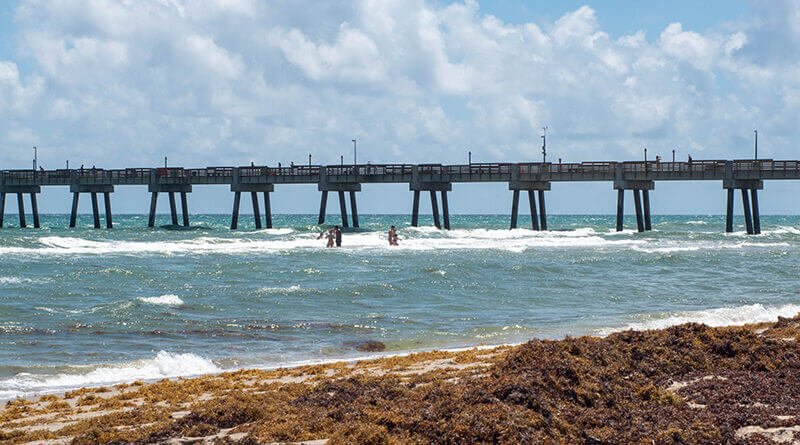Bizarre Facts: Record Breaking Seaweed Blob Leaves Tourists Unhappy
KEY WEST, FL.— A massive blob of Sargassum, a genus of large brown seaweed that floats in island-like masses and never attaches to the seafloor, is heading towards Florida, and people are not happy about it. The giant blob stretches 5,000 miles across the Atlantic from Africa and has grown larger than ever, according to scientists. The blob is already reaching shorelines in Florida and Mexico.
NASA and other agencies have been taking satellite images of the blob that are being reviewed and studied by the Optical Oceanography Laboratory at the University of South Florida to measure the size and direction of the blob, which is currently weighing in at 3 million tons as of March.
“These blooms are getting bigger and bigger and this year looks like it’s going to be the biggest year on record,” Dr. Brian Lapointe, a research professor at Florida Atlantic University who’s spent his career studying Sargassum algae, in an interview with The New York Times.
Sargassum is a floating habitat that can provide food, refuge, and breeding grounds for various species in the ocean, such as sea turtles, marine birds, crabs, shrimp, and more. There is even a species called the sargassum fish, which lives its entire life in the habitat. When the seaweed blobs lose their buoyancy, they will sink to the seafloor, where it provides energy in the form of carbon to fishes and invertebrates, making them a potentially important addition to the deep-sea food web.
A less favorable characteristic of this 3-million-ton floating seaweed bed is the gas it emits that smells like rotten eggs as it arrives at beaches just in time for summer.
Scientists have been tracking the gigantic blooms across the Atlantic Ocean since 2011, but this year is setting records regarding the size.
“Looking ahead, the total Sargassum quantity is expected to increase over the next few months, with impacts of beaching events in the CS and GoM worsening accordingly,” said the USF Optical Oceanography Lab in a report from April. “Sargassum aggregations east of the Antilles Islands and in the CS will continue to accumulate and migrate westward, while abundance in the GoM will likely increase substantially. Impacts of Sargassum beaching events will continue to be felt throughout the CS and GoM coastal regions, although it is difficult to predict exact timing and location for individual beaching events. We will continue to closely monitor and track Sargassum in each region, with more summary updates provided by the end of May 2023. Meanwhile, daily updates through near real-time imagery can be found under the Sargassum Watch System (SaWS, https://optics.marine.usf.edu/projects/saws.html).”
Leaving the seaweed alone poses problems. The seaweed blob contains arsenic which can soak into groundwater and contaminate it and potentially pose significant threats to public health, such as cancer and skin lesions when exposed to it for long periods of time. Currently, scientists are working to understand why the seaweed is growing so much and what measures need to be taken to manage it. But until that happens, large clumps of the stinky seaweed will continue to wash ashore and inconvenience the beachgoers.


